It’s hard to know where to start in Vienna. Literally. I’m off the plane and moving towards…the door? The metro station? Google Maps is giving me lots of ways. There’s a direct airport train at a premium. I feel like the metro is my best option – if I want to understand Vienna – but there are multiple paths to take. There’s no guide by the ticket station so I ask a salesman at a chocolate store. He gestures towards the metro and so down I go. I’m lost immediately. I pay for a ticket to…somewhere, confident I’m at least not stealing. I eventually lean on another tourist who has done this before.
The language barrier doesn’t help – as I’m reading things in German, but also there are train lines and metro lines layered on each other. And the stations are called a different name depending on which line you take. I get to where I’m going, dragging my protesting luggage along the cobblestone. Just.
Like many ancient cities, Vienna is not a square or a rectangle. The middle of the city is encircled by the Ringstrasse (it took me two days to figure out that ‘strasse’ means street….). The Ringstrasse is now a boulevard that follows the original fortification that protected the city. It was significantly redeveloped in the mid-19th century and the buildings inside are grand and spectacular. It is truly amazing. The tourists flock like seagulls.
At the end of my first meeting my colleague suggests I go to the museum around the corner. I foolishly don’t pay attention to the name. Vienna has a lot of museums, and art galleries and cultural events – Spanish riding school, the opera. Palaces. I ask a colleague whether he’s ever been to the palace and asks me which one. There’s a 3 day pass to one of the grand palaces, which includes a building turned into an art gallery featuring Klimts. There’s a lot of culture in Vienna.
And a lot of social housing. While Copenhagen’s social housing scene has sparked recent interest, Vienna has been on the map for a long time. Here is an Austrian case study produced by the Australian Housing Urban Research Institute from 13 years ago. Here is a more recent ABC article, a Guardian article, a Canada CBC article considering the Vienna model, another article considering the Vienna model in Southern California. If you’re into social housing, Vienna is where it’s at.
And they know it. More than one colleague gives me reading material to take away. I’ll have to put it in my carry on if I want to make my baggage allowance. Vienna knows they are world leaders in social housing and they know that other countries are envious. Cities come to them for advice directly. One of the colleagues I speak to has the title of ‘International Relations’. The City of Vienna employs people to talk about their great social housing scene, to speak to people like me.
What makes Vienna so great? Here’s the quick version.
· They have a cost-based/cost-recovery model. There are caps on building costs, which then means there are caps on rents. Social housing is almost universal, with only the very wealthy excluded. There are rental subsidies for very low incomes.
· There is both public housing and community housing. The latter sector is called Limited Profit Housing Development (LPHD). Public housing is generally for lower income households as LPHD are cooperatives, requiring an initial membership fee. Both sectors are about the same size.
· There is readily available low-income debt. Commercial banks invest in a way that shows that social housing is low risk. There are low interest government loans, mixed with private capital and paid off over the long-term by tenant rents.
· The city undertakes land banking. It has a fund for this purpose call the Fund for Housing Construction and Urban Renewal (wohnfonds_wien) which is a distinct, not-for-profit entity. Land is released based on the strategic needs of the City. There are developer competitions for large sites, with 4 main criteria: economy, social sustainability, architecture, and ecology.
· There is income and reoccurring capital to develop, maintain and upgrade social housing. Cooperatives have shareholder contributions. There is income from rents. Loans are repaid. There is a tax, like income tax, that is collected federally and then distributed to local areas for housing and infrastructure. In Vienna, there is an on-book, annual budget for housing.
· Vienna has a housing plan. They conduct research. They have long-term horizons.
Most people live in subsidised housing – 60%. There is so much social housing that it has a ‘dampening effect’ on market housing – as in private rental needs to benchmark their rent against social housing rentals to be competitive. Can you imagine?
There is a long housing history in this city. They didn’t always get it right, but they’re also prepared to keep adjusting. Vienna tried rental moratoriums in the early 20th century to help ease the health issues of overcrowding. This indeed reduced overcrowding in single dwellings, but increased overall demand.
Vienna has had more than one period of housing renewal. The Ringstrasse may attract the most tourists, but people like me headed straight to housing made famous during the period known as Red Vienna – mass urban redevelopment in the inter-war period. Karl Marx-Hof is probably the most famous – it’s huge, with over 1200 units. There are tunnels mid-way along the development at the street level to allow for roads. The courtyards are, immense – easily the size of local parks in Melbourne. I sit on a bench outside for an hour in silent glee. Lifegoal achieved.
‘Look up and you’ll see the sign everywhere,’ a housing policy expert tells me. Sure enough, Vienna not only built public housing, but named and date stamped it. Once I know what I’m looking for, I can’t stop seeing it everywhere. And it comes in all sorts of shapes and sizes.
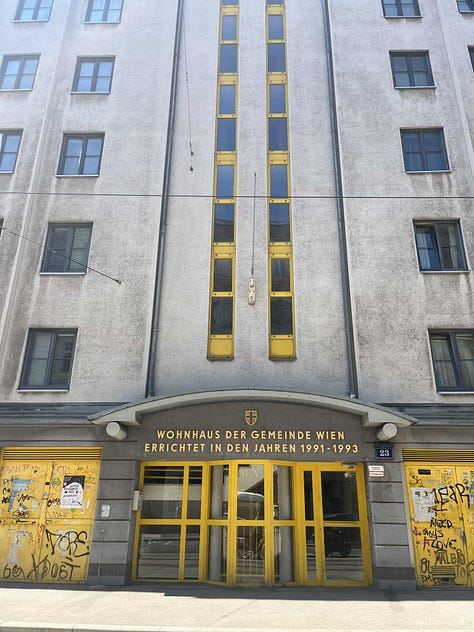
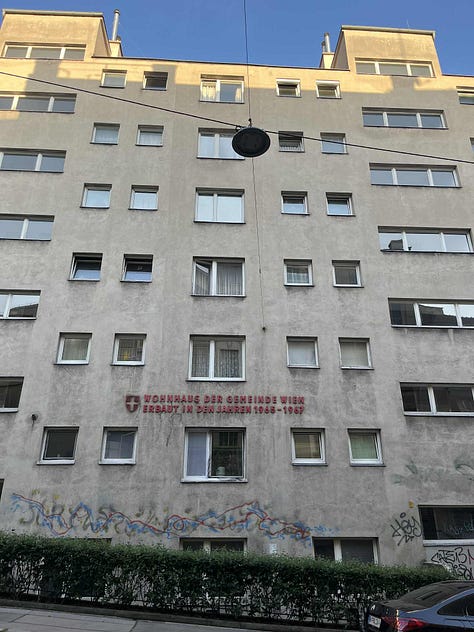
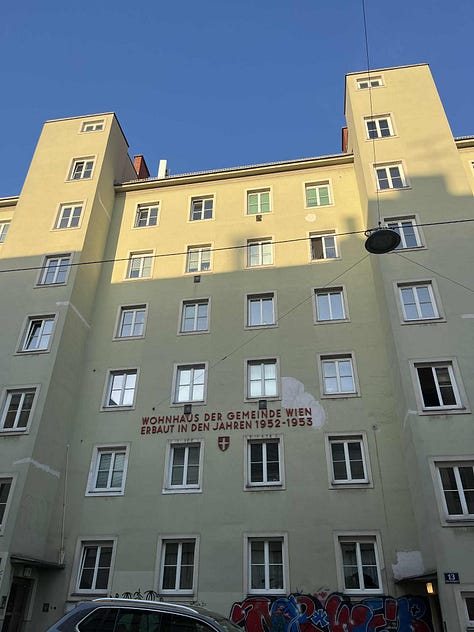
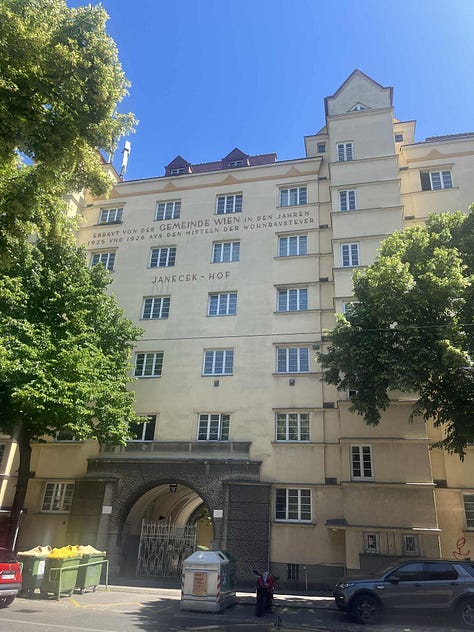
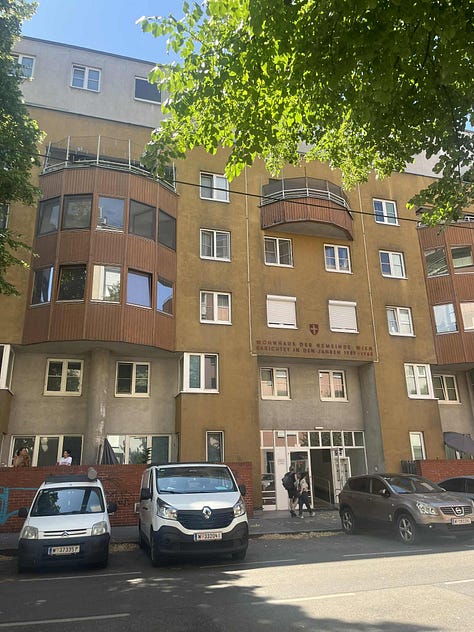
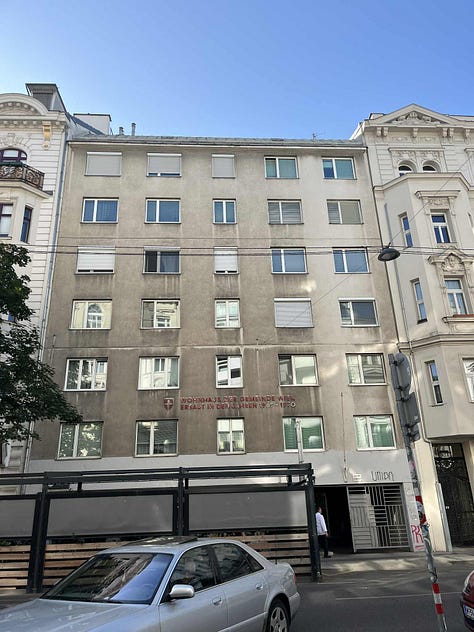
Another colleague tells me about the red thread of Vienna’s housing policy. I’m confused – as we were just talking about the generous courtyard of Karl Marx Hof. There’s a lot of red things related to social housing in Vienna. Indeed, red seems to be the brand colour of the entire city. It’s like a Tiffany’s soft blue or the purple of Cadbury’s. She tells me the red thread is the link between the physical space and the people. She’s talking about how good architecture can create community, and how strong communities create healthier people. She’s preaching to the converted, but it refreshing to hear that cost per square metre isn’t the only criteria.
‘Is it socialism or capitalism that drives the affordable housing market?’ I’m in the heartland of social housing and I want the essential ingredients. ‘It’s in between,’ says an economist. ‘It’s a social service of general interest,’ is the answer. He talks about EU competition law, about the efficient industries Austria has developed to ensure people are housed, about subsidies and land as a finite commodity. ‘The housing market cannot be left on its own.’ I’ll certainly be adding that line to my final report.
‘Where do we start?’ I say it almost in a whisper. I’m speaking to a policy expert that has advised many jurisdictions. I can handle the truth. He’s already told me that there is no easy answers if Australia wants to build a similar system to Vienna. Others are already trying. Ireland spent years talking to both Copenhagen and Vienna before launching their cost-rental housing apparently. Los Angles and Vancouver are also consulting. But I don’t want options - I want the most direct path.
‘It’s all about the land,’ he tells me. I push further for clarification. The City of Vienna purchases land through a revolving fund. They use zoning in their favour. There’s MIZ. There’re public land leases, and brownfield competitions for not-for-profit developers. Which lever is he alluding to?!
He tells me a story about Vienna post-GFC. Land prices started to rise due to market activity. Housing speculation. The City of Vienna brought in new planning rules that required 75% of large redeveloped zones to become social housing. The government purposely stopped large scale development speculation by making it uneconomical to take it on. My colleague who tells me this says it as a matter of fact. He’s not glib – there was an emerging problem and government figured out a way to solve it using the powers it had.
He talks about market players not as evil adversaries, but as actors that can weaken a strong housing system. They are motivated by profit, he reminds me. It is a simple truth – and my brain quickly counts the ways for-profit organisations receive housing subsidies in Australia. ‘Cheap land is key,’ he’s finalising his summation, ‘with a non-profit housing developer. It can become a market unto itself.’
I leave Vienna with lots of answers. I’m still considering the right path forwards.





so many fantastic options that just require everyone to calm down re development profits